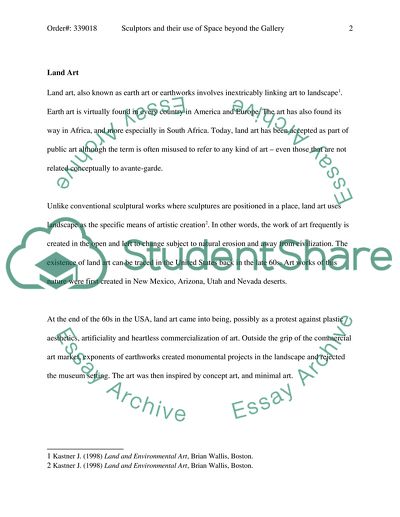Cite this document
(Sculptors and Their Use of Space beyond the Gallery Article, n.d.)
Sculptors and Their Use of Space beyond the Gallery Article. Retrieved from https://studentshare.org/visual-arts-film-studies/1730110-using-specific-examples-discuss-the-ways-in-which-sculptors-have-dealt-with-space-beyond-the-gallery-take-richard-serras-two-sculptures-as-an-example-of-public-art-and-two-examples-of-land-art-by-robert-smithson
Sculptors and Their Use of Space beyond the Gallery Article. Retrieved from https://studentshare.org/visual-arts-film-studies/1730110-using-specific-examples-discuss-the-ways-in-which-sculptors-have-dealt-with-space-beyond-the-gallery-take-richard-serras-two-sculptures-as-an-example-of-public-art-and-two-examples-of-land-art-by-robert-smithson
(Sculptors and Their Use of Space Beyond the Gallery Article)
Sculptors and Their Use of Space Beyond the Gallery Article. https://studentshare.org/visual-arts-film-studies/1730110-using-specific-examples-discuss-the-ways-in-which-sculptors-have-dealt-with-space-beyond-the-gallery-take-richard-serras-two-sculptures-as-an-example-of-public-art-and-two-examples-of-land-art-by-robert-smithson.
Sculptors and Their Use of Space Beyond the Gallery Article. https://studentshare.org/visual-arts-film-studies/1730110-using-specific-examples-discuss-the-ways-in-which-sculptors-have-dealt-with-space-beyond-the-gallery-take-richard-serras-two-sculptures-as-an-example-of-public-art-and-two-examples-of-land-art-by-robert-smithson.
“Sculptors and Their Use of Space Beyond the Gallery Article”, n.d. https://studentshare.org/visual-arts-film-studies/1730110-using-specific-examples-discuss-the-ways-in-which-sculptors-have-dealt-with-space-beyond-the-gallery-take-richard-serras-two-sculptures-as-an-example-of-public-art-and-two-examples-of-land-art-by-robert-smithson.


